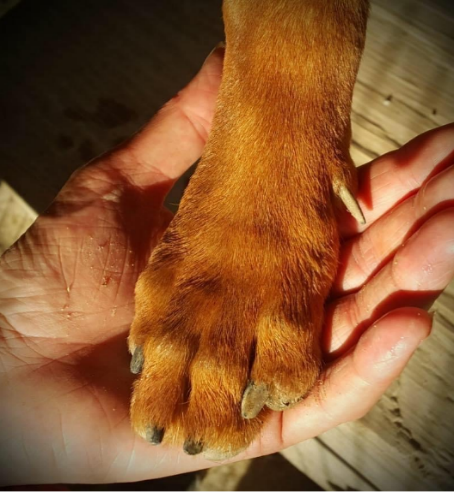
Rescue dogs are not broken, they have simply experienced more life than other animals. If they were humans, we would call them wise. They would be the ones with tales to tell and stories to write, the ones dealt a bad hand who responded with courage. Do not pity them. Here we discuss settling your rescue dog, what to expect and how to manage the first few months integration.
Be proud to have their greatness by your side.
First of all be proud, you are giving a rescue dog a home and that is beyond amazing. Naturally, you are excited and want to introduce your new arrival to their wonderful new life. But, before that, it is important to create both a bond and trust between you and your dog. Settling your rescue dog requires patience and understanding in the first few weeks of your relationship can mean the difference between creating a happy, peaceful environment for everyone in the house and the alternative of returning your dog to us. An outcome no-one wants to happen.
Every rescue dog is different. Some settle immediately and others need a lot more time. What works with some will be unsuitable for others and the first few days can be stressful for your dog and you. It is great to keep in touch with other adopters but do not judge your dog, or yourself, with progress in another home.
Dogs that are returned to us early in their adoption have usually never relaxed enough to be themselves in their new home. So, you need to be emotionally prepared! There may be lack of sleep, mess and stress – rescue can only work with your love and patience.
Remember the Rule of 3 to settling your rescue dog – your dog needs:
o Feels overwhelmed
o May be scared and unsure of what is going on
o Not comfortable enough to be themselves
o May not want to eat or drink
o Shut down and wants to curl up in a crate or under a table
o Tests the boundaries
o Starts to settle in
o Feels more comfortable
o Starts to realise this could be a forever home
o Works out the environment
o Gets into a routine
o True personality starts to emerge
o Behaviour issues may start
o Comfortable in the home
o Building a bond and trust
o Sense of security with family
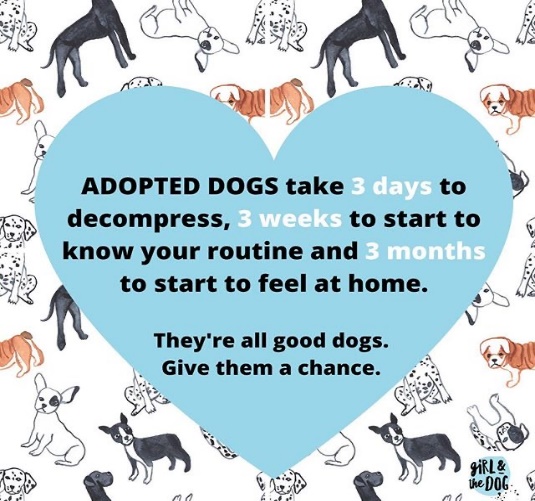
Try and think from your dog’s perspective. They may never have been in a home before, there are new human rules and regulations, collars, leads and harnesses, set mealtimes, and toys, amidst an array of sights, smells and sounds. What we take for granted are all likely to be frightening to your dog, who will most likely have never experienced anything like it. Imagine you have been transported to a country where you don’t understand the culture and customs, no-one speaks your language, and you don’t know anyone. This is just a fraction of what your rescue dog will be experiencing. Understanding this culture shock will help you to realise why we need to find ways to reduce the pressure and help them to feel safe.
To help you you with settling your rescue dog, we want you to know exactly what to expect when your dog arrives from Cyprus, whether you are fostering or adopting. To help ensure you successfully introduce your new companion into the family it is important that you read this guidance which takes you step-by-step from the moment your rescue arrives through the first three days, three weeks and three months. This time is critical but if you are prepared to be understanding and patient, your dog will settle in must quicker and the foundations are laid for a rewarding relationship. Each dog is an individual with its own needs and with its own past and history to overcome but with your help, love, patience and guidance it will live the life it deserves.
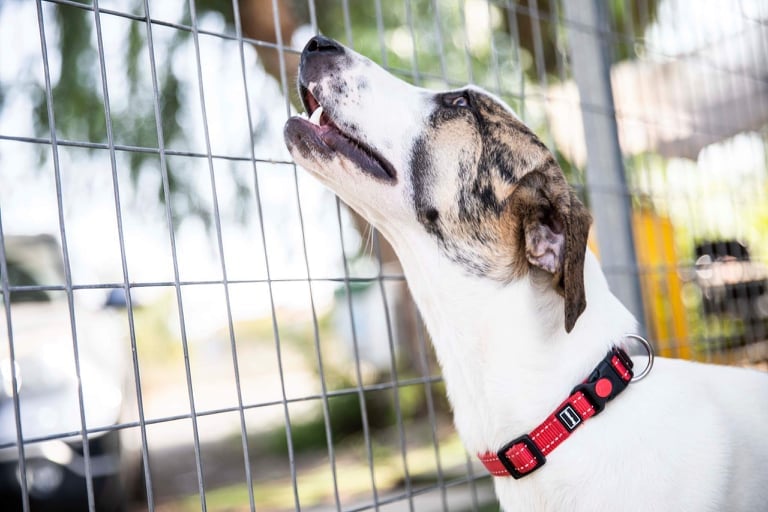
Remember where your dog has come from. Some dogs may have been fostered in Cyprus, but most will be travelling to you from the Dali shelter. Here they have been surrounded by many other dogs and lots of unfamiliar barking and smells which can be intense at times. This means their minds are highly active as they are constantly stimulated and they may be stressed, particularly if they have been there for a few months.
It is also important to remember why they arrived at the shelter in the first place. There may be sadness and confusion if your dog was given up by a previous family. Your dog may have been rescued from the streets where it has fended for itself living in fear. Some dogs have suffered neglect and abuse.
Then one day everything changes for them. They are put in a crate and taken by road to the airport, taken out of the crate for checks and put back in the crate for the flight, taken out of the crate and put in a pen in a pet transportation vehicle for delivery to you. This is wonderful for us as we know this is the start of their new life in their forever home. But imagine what must be going on in their minds! The journey and such a drastic change are stressful and as you need to be prepared to help them make the transition. This takes time and patience.
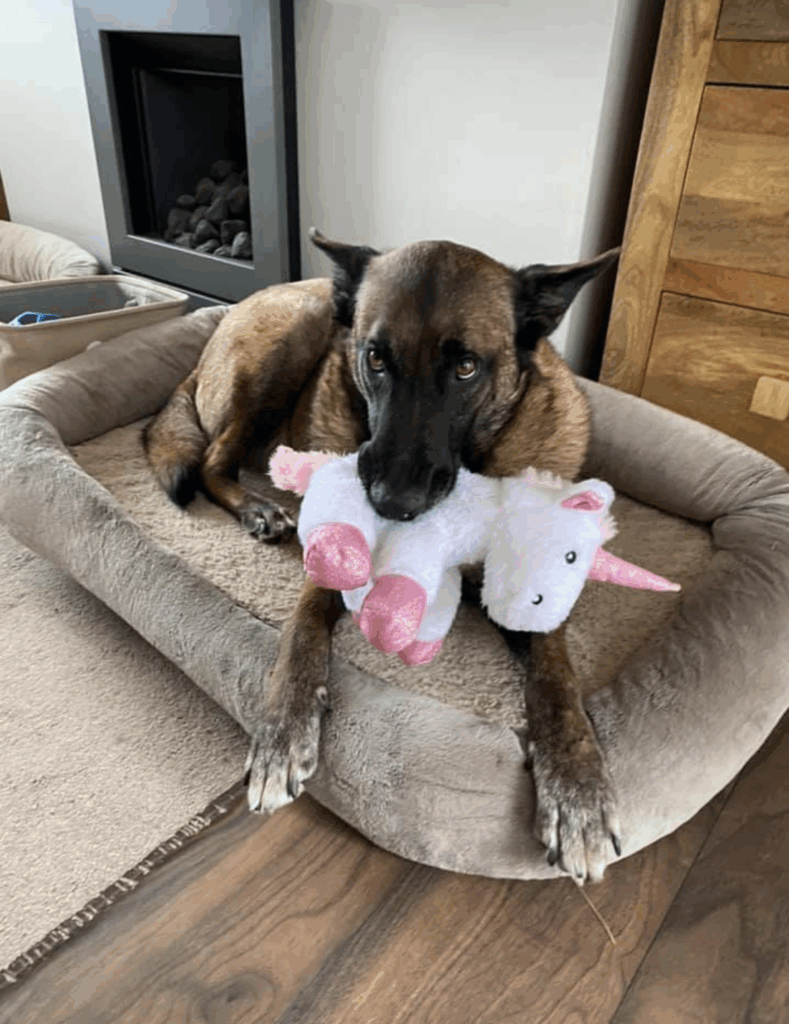
Make sure you are prepared. Think about where your dog will live when they come home. Decide if there are any areas where your dog will not be allowed and use gates and barriers if necessary. It is important you are consistent to help your dog learn and not become confused. It is not helpful if dad says no to the bedroom and mum allows access when dad is not there!
Set aside a place for food and water. Your dog will need a few cosy places in your home where they can rest and relax. Soft comfy bedding will create these safe places and can be used as a place to retreat. These places are best in quiet corners of your home but not in areas where the dog can self-isolate. It is good to offer the dog a safe area where the normal home life can be observed, but from a safe distance. It is also advisable to have a crate to provide the best decompression time and this is explained in more detail below. Set the crate up before your dog arrives and makes sure it is the right size and has comfortable bedding and a toy (for example a kong that can be filled with treats) to help pass the time. Have a supply of treats to use to reward your dog when they use the crate to help them feel more comfortable in this new and strange environment. Get a good quality harness and lead and a slip lead for collection.
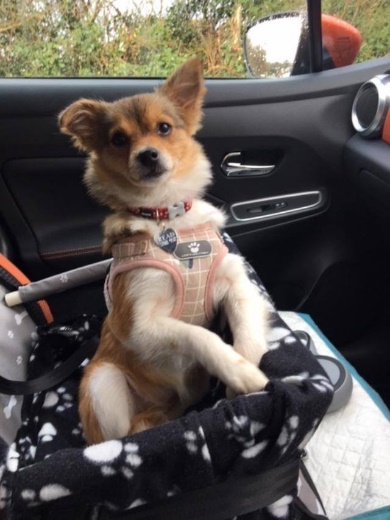
Your dog has probably been travelling to you for 18-24 hours, in a crate on an aircraft and in a cage in a moving van, in a cramped space surrounded by other unfamiliar dogs. Collection will be at a specified venue, usually a service station. Some dogs may be in shock and afraid and have no idea that the strangers who have arrived for them are their forever family. Be aware that some dogs may try to escape, and you must take a slip lead to ensure that your dog can be safely moved into your vehicle.
Once you arrive home, take extra precautions to ensure your dog cannot escape when you open the car door. Have someone with you who can hold the lead (or the dog) throughout the journey, and who can ensure that your dog does not bolt as soon as the door opens a little. Once your dog is indoors, remind the rest of the household to be very careful when entering and leaving your home. Keep accessible windows closed. If necessary, put the dog in a separate room when the doorbell rings, to ensure they stay safely inside. Keep a check on outdoor boundaries; make sure the boundary fencing is adequate to contain a potential escape artist, and check that gates are kept securely bolted.
Despite your excitement avoid excessive handling and petting. Letting the dog come to you takes pressure off them. Avoid the human temptation to try and comfort your dog with touch. Most humans respond well to physical contact as this is our nature but in the canine world, it is a stressor and a threat to a scared dog. Similarly, humans use eye contact to convey support and trust but eye contact from an unknown dog or person, to a dog, is interpreted as a threat. Glancing away acts as a calming signal.
Do not put your face in your new dog’s face. They do not know you and this can be intimidating for them. They need to trust you first and do not assume that they do because they appear friendly. If your dog is afraid speak in a soft voice and stoke gently but with a calm positive energy. Do not feel sorry for them as this energy will reaffirm their fear.
Introduce your dog to your home by giving them a brief tour of their main living area or the places they will be the most often. The most important thing you can do is to take steps to reduce the stress your dog is experiencing. A comfy dog bed in a quiet area or a crate provides a safe retreat and resting place. Your dog will be exhausted after the long journey, so make sure there is plenty of water close by, offer a light meal, and leave them to rest. If your dog is nervous of a food bowl you could scatter food close by.
Ideally rest will be taken in a crate and this is time to let them take in everything that has happened so far. The crate is their safe place, it is not a prison or a punishment place but a ‘den’ that is very natural to them. They may cry initially but with time they will accept their time alone and realise it is not bad. Crate treats may help but it is important not to go and cuddle them or give other attention when they are crying as this reinforces that if they cry or bark, they will be let out of the crate.
Most of all if your dog is scared or traumatised you need to give them space. They need space to feel safe and if we look at them or touch them too much, they cannot feel safe.
To help a rescue dog settle it is important to establish a routine, a time, an area and a place within that area to place their food and water. Some dogs will eat straightaway and others may be scared to eat particularly if an unknown human is nearby. It is a good idea to put the food down and walk away, but not leave the area altogether. A dog will usually eat if you are a few metres away. Do not stand over the food and call the dog to it as this is far too much pressure for them. If your dog refuses to drink but is eating, try mixing water with their food. To avoid dehydration if your dog refuses to drink after 24 seek veterinary advice.
Choosing dog food is a whole other guidance document but on arrival a small bland fat free meal helps a possibly unsettled tum to adjust. Cooked turkey or chicken and plain 100% pumpkin (plain canned or fresh) is perfect. An alternative to pumpkin is sweet potato or even instant mashed potatoes. Chicken and rice are often also recommended but even though rice is bland it is also fermentable and, in some dogs, can add increase gassiness.
To help your dog make the transition from the shelter to your home give them time and space to ‘decompress’. Decompression time means allowing your dog to get back to a calm state of mind. The amount of time required for this varies with each dog and can last from the first day to a few weeks or in some extreme cases a few months. As a minimum, expect three days. During this time treat your dog with respect and mindful regard and bond through quiet times together.
During decompression they need to know that their new guardians are in control and that you will protect and provide for them, giving them clear expectations and routines to follow. It is also important that you avoid scenarios that encourage negative behaviours to surface. This includes avoiding introductions to people other than those in their home in the first few days. Imagine you have just met a new friend and on the first day of this new relationship they wanted to introduce you to their family and friends who all insist on hugging and kissing you constantly. Would you consider your new friend someone you could trust when they have put you in situations that you feel unsure and uncomfortable? Your family and friends may be keen to visit, but it is best to make your home a visitor free zone for at least the first few days to give your dog some time to become familiar with your home and immediate family.
Imagine as well that all these people speak a language you don’t understand and that you are expected to interact in a positive way with everyone – at best you would be a bit reserved and possibly detached. You may even be afraid and want to retreat to a safe place.
Your dog will no doubt like you but does not know you yet. Facing new people, new routines and new rules are all additional challenges that adds to the dog’s stress and they may all react by becoming defensive and short-tempered, fearful or shy. Your dog needs a teacher and calm predictability to get back to a neutral and relaxed state of mind. Time and thought should also be given to introducing your new arrival to other pets in the family.
Trust is the key to building a positive relationship. Without this trust a dog might display unwanted behaviours such as growling when moved off the furniture or nipping at children because they don’t understand them – we then harshly correct them before we have even taken the time to teach them what is expected of them.
By giving the dog decompression time it gives them time to see you, meet you, hear and take in the new sounds and smells of your home. It is tempting to want to make a fuss of a new dog, to show affection and show your love for them. However, this can be intimidating for some rescue dogs, so be guided by your dog. Speak softly, use their name when you call them and when food is involved, so that they quickly learn their new name and begin to associate it with good things happening. Move slowly. Glance sideways instead of looking directly at them, so that they understand your intentions are friendly. Keep your voice soft. Touch them gently on the chest or flanks if they approach you, but ask everyone in the home not to approach them, and to only stroke them if they ask for that by moving close and showing inviting body language such as nudging or leaning in, soft eyes, an open mouth with a lolling tongue, a wiggly body and tail.
As much as you want to, do not engage in hours of cuddles and tummy rubs because you feel bad that your dog has had a bad past. Too much affection can reinforce an unbalanced state of mind and confuse your dog. Have a daily routine including toilet breaks and crate time. Dogs find comfort in routine.
If necessary, keep out of the crate interactions short; 20-30 minutes is recommended to keep the interactions positive and to reinforce the crate training. You can increase the time out as the day’s progress. The crate is the tool used to help your dog process the new information they receive in their interactions with you. Being in the crate allows your dog to learn about their new family and new home. They have an incredibly powerful sense of smell allowing them to ‘smell before they see’ and they can literally explore the house with their nose from the crate without the stress of a face-to face meeting where body language might be misunderstood. Progress will be quick particularly if this is your only dog. Once they are in a routine and look relaxed and confident you can consider removing the crate.
Ideally do not allow your dog on sofas and beds to begin with. Create safe comfy places around the house for them. Sofas and beds can come later if you want.
Some dogs may have never lived indoors. Some may have been born in a home and then dumped or abandoned. Others are born on the streets or in the surrounding countryside. Some are born on property but are kept outside on a chain. Your dog just needs to learn the difference between indoors and outdoors, and to be rewarded every time they ‘go’ outside.
To teach good toilet habits it is important that you go outside with your dog, and ensure you have a pocketful of treats at all times so that you can reward by praising softly and dropping a treat on the ground right in front of them every time they eliminate. Toilet training needs to be an established routine and this with clear guidance helps dogs learn quickly.
Opportunity should be given to go outside and toilet first thing in the morning, immediately after eating or drinking and regularly spaced throughout the day. If there is another dog in the house, a new rescue dog will often learn from their established behaviour. A dog that toilets in the house should never be punished, they know no different and punishment will lead to stress, mistrust, fear and all lead to further indoor accidents. A good toileting routine is about capturing and rewarding outdoor toileting and ignoring indoor accidents.
Unneutered males may carry out marking behaviour, particularly when they are feeling insecure. They may leave little wet patches on walls, chair legs etc. Most dogs are neutered before going into homes, but this does not always stop anxiety-based marking behaviour. With anxiety-based marking, working on the dog’s stress levels and confidence will help. It is worth checking with a vet that there is no underlying issue such as a bladder infection which increases the need to urinate. Urine eliminator is a must, as any remaining traces can further encourage urinating in the same spot.
Expect some accidents. The stress of the journey and a new environment can lead to accidents even if your dog has previously been house trained.
Walks are not essential during the first few weeks. In fact, keeping your dog at home gives your dog a chance to become used to the new environment without additional stress. Also, walks provide an excess of stimulation and you need to build up trust first before encountering the many variables encountered on the typical walk. Instead, exercise your dog in the garden on a long lead (20ft plus ideally) and spend time getting to know each other. Do not take them to shops, dog parks, other people’s homes etc. These situations provide an overabundance of stimulation that your dog needs to have the trust built in for you to handle the situation so they don’t have to. Also remember that most of the rescue dogs will not be used to daily walks.
It is good to keep your dog in a crate until the decompression period has ended and everyone is adjusted and comfortable. Once your dog learns that you always come back again when you leave and settles in the crate you can then decide if they are to be free when you leave. Separation anxiety is very real, and it is important to practice brief absences during the decompression period and keep greetings and goodbyes low key to help the dog adjust. When you leave your dog, calm music such as classical music, can be left playing as this can help slow down the heartbeat and racing mind of a stressed dog.
For at least 3 weeks your dog’s life should be simple and boring. Keep the affection to a minimum, keep talking to a minimum and training non-existent. No obedience training, just fun, exercise and maybe some toys.
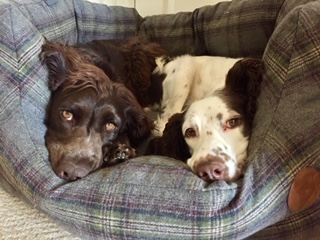
Many rescue dogs are more comfortable around other dogs, and a calm, confident resident dog can boost a new dog’s confidence and help them settle in more easily. But remember everyone in the house needs time to adjust and the key is to take things slowly and keep things positive. Ideally for the first two days (at least) keep your new dog and the others separated. Let them sniff around the new dog’s crate, ‘see before touch’. Remember your existing animals do not know this ‘intruder’ and your new dog doesn’t know the house or what is permissible. Setting a routine for your new dog first – before the introduction and distraction of other dogs and animals will make the integration so much easier.
If you already have a dog, or dogs, it is best to introduce them to your new family member in a neutral place outside, to avoid any risk of territorial behaviour. You will need to have a person for each dog, and you can go for a short walk if your new dog is coping with being on lead. It can help to take it in turns for the dogs to follow each other, as this gives them the opportunity to catch whiffs of the other dog’s scent. Have the dogs on the outside and humans on the inside, so that they feel safer. Watch for body language that shows any of the dogs are stressed: low body, low or tucked tail, avoidance behaviours, tucked back ears, lunging, barking, showing the whites of the eyes, raised hackles, and flattening to the ground are just some of the things to look for. If the dogs seem to be relaxed you can allow them to move closer if they choose to, but do not force them to interact.
The three second rule is very useful for all dog introductions. If they show signs of wanting to greet each other, allow them to move close enough to sniff for three seconds and then gently move them apart. Repeat this for as long as you feel is necessary.
Once indoors, having them in separate rooms or areas with a safety gate between them can help each dog adjust to the other’s presence without feeling threatened, and allows them to see and hear each other and get accustomed to their new companions while reducing stress. If this goes well you can introduce them in the home, again keeping leads on initially – this helps you keep things under control if something does go wrong. Keep new interactions short initially, 10-15 minutes, and end on a positive note and give all the dogs’ time to process everything that has happened. This allows all the dogs to enjoy each other’s company without becoming overstimulated and gives them the desire to want more interaction. It also reinforces that you are in control, not them. If you control when and how long they interact you are reinforcing that you are the person that they look to for direction and you need that with multiple dogs.
Over the next few days, you can increase the time together. Do not allow them to become over excited as this can quickly amplify and get out of control. Pay attention and supervise play initially. Monitor toys! It is better during the first interactions not to have toys and let the dogs learn about each other before introducing something that may be high value to one or more of the dogs. Give them time to learn each other’s signals for play and for ‘no’ – this allows you to learn these signals as well.
Your dog may not be used to wearing a collar, harness and lead, and may find it overwhelming to be taken out for walks during the early weeks. You will not want to add to the stress, so when short practices in loose lead walking in the garden each day will get your dog used to the strange sensations of being attached to you. It will not take long to learn that this is fun, and you can then start with very short walks and increase the time spent outside your garden according to how comfortable your dog seems. If anxious please bring them straight home, so that they understand that you are their protector. You can try again the next day – there is no need to rush.
Capture is a traumatic and often painful process, especially when a catch pole is used. Because of this, some rescue dogs are very sensitive about being touched around the neck and head area. Your dog may become very anxious about wearing a collar and lead; even more so if the lead is attached to the collar. You may need to spend time just letting your dog get used a collar and loose lead in the house.
It may be more comfortable for your dog if you use a harness, and a harness with an extra D ring fitted at the front as well as having the D ring, as usual, on the back avoids the risk of any pressure on the neck area, and your dog can sleep in the harness initially so that you don’t have to worry them by taking it off and putting it back on periodically.
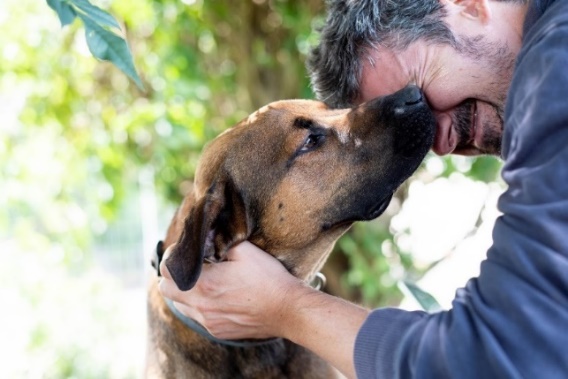
The honeymoon period varies depending on each dog but ends when the dog has adjusted to their new life; on average after 3 months. At this point the following can happen:
• Past learned behaviours that have been dormant can emerge;
• New behaviours can appear that have been accidently reinforced in the new home.
Look out for these and remember we are here to help and support you if needed!
This can be managed well if you continue to set fair and consistent guidance, so the dog knows exactly what is expected.
When settling your rescue dog the most effective way to prevent problem behaviours from emerging, after the honeymoon or settling in period, is to ensure the dog understands the boundaries. It may be tempting to be lenient in the beginning when building a bond, but if this is changed later the dog will be confused. Use positive training methods as encouragement for behaviours that are acceptable, reward good behaviour and ignore the problem behaviours. Create a predictable routine that your dog can understand.
It is also important to remember that a ‘problem’ behaviour may be due to pain or discomfort and a visit to the vet will help rule this out or identify the issue. Again, we are here to help and support you so please contact us if you have any concerns.
The relationship that develops between a rescue dog and their new family can be an extraordinary gift on both sides. Being sensitive to your dog’s feeling and needs and being patient and gentle are the keys to building a lasting loving relationship.

You can’t change a dog’s past, but you can rewrite its future – write with care.
We have a very active and supportive group of adopters. We have created a Facebook group so that they can share their photos of their rescue dogs with other adopters and the rescues they came from. They are also there to support each other and ask any questions to the admin team. The group can be a great support to you when settling your rescue dog.